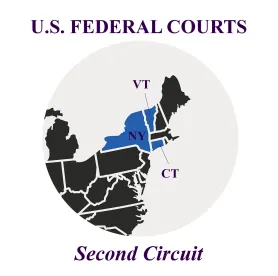On May 22, 2020, Judge Paul G. Gardephe of the U.S. District Court for the Southern District of New York granted a motion to dismiss in Kirschner v. JPMorgan Chase Bank, N.A.,1 finding, inter alia, that the syndicated loans at issue in Kirschner are not securities for purposes of state securities laws by applying the “family resemblance” test set forth in Reves v. Ernst & Young.2 While investors and originators wait for widespread activity to return to the $1.2 trillion new-issue market for U.S. leveraged loans,3 the timely Kirschner decision reaffirms the widely-held understanding that syndicated loans are not securities. Kirschner should alleviate4 concerns about the ability of U.S. banking entities to rely on the “Loan Securitization Exclusion” under the Volcker Rule to invest in collateralized loan obligation (“CLO”) securities backed by broadly syndicated loans, as well as concerns that participants in the syndicated loan market might be subject to liability under the securities laws. The analysis underlying the Kirschner decision also provides a reminder that there are no bright-line rules for lenders and originators to ensure loan treatment for debt instruments and that careful documentation of syndicated loan transactions is essential.
Background
In 2014, Millennium Laboratories LLC (“Millennium”), a California-based drug testing company, entered into a $1.775 billion syndicated loan transaction evidenced by notes, which was arranged and underwritten by a number of banks and broker-dealers (“Defendants”). Months after the loan was syndicated, however, Millennium became embroiled in legal disputes with both federal regulators and civil litigants amid allegations of healthcare fraud, including the U.S. Department of Justice’s decision to intervene, after a years-long investigation, in False Claims Act proceedings brought by qui tam relators. Millennium’s legal troubles—including an adverse jury verdict and a $256 million settlement with the Department of Justice—ultimately resulted in the company defaulting on the loan and filing for bankruptcy protection in November 2015 in the U.S. Bankruptcy Court for the District of Delaware.
On August 1, 2017, the trustee (“Plaintiff”) of the Millennium Lender Claim Trust (the “Trust”)—the litigation trust formed as a result of Millennium’s bankruptcy—filed suit against Defendants in the Supreme Court of the State of New York, New York County, on behalf of the Trust’s beneficiaries. Plaintiff, arguing that the leveraged loans at issue were “securities,” alleged that Defendants violated the state securities laws—commonly referred to as “blue sky laws”—of California, Massachusetts, Colorado, and Illinois, by misrepresenting and omitting material facts about Millennium’s fraudulent business practices and the legal and financial risks it faced “in the offering materials they provided and communications they made to Investors.” In addition, Plaintiff asserted common law causes of action for negligent misrepresentation against all Defendants, as well as claims for breach of fiduciary duty, breach of contract, and breach of the implied covenant of good faith and fair dealing against JP Morgan Chase Bank, N.A. (“Chase”) in its capacity as “Administrative Agent” for the Millennium syndicated loan transaction. On August 21, 2017, Defendants removed the case to the Southern District of New York, asserting the Edge Act, 12 U.S.C § 632, as the basis for federal jurisdiction.
Defendants then moved to dismiss Plaintiff’s complaint. With respect to the state securities law claims, Defendants argued that syndicated bank loans, including the notes issued pursuant to the Millennium syndicated loan transaction, are not “securities” and that a loan syndication is not a “securities distribution.” Defendants asserted several bases for dismissing Plaintiff’s negligent misrepresentation claim, including that Plaintiff’s allegations constituted fraud by hindsight, and that the claim was barred by the terms of the industry-standard credit agreement that governed the syndication (the “Credit Agreement”), which stated that the lenders were responsible for their own investigation of Millennium’s financial condition and disclaimed all reliance by the lenders on information provided or omitted by Defendants. Defendants also argued that Plaintiff’s common law claims against Chase were all barred by the terms of the Credit Agreement.
The Court’s Holding
I. State Securities Law Claims
To determine whether instruments such as the Millennium notes constitute “securities,” the Court looked to the four-factor family resemblance test articulated by the U.S. Supreme Court in Reves v. Ernst & Young. The Reves test begins with the presumption that every note is a security, but that presumption may be rebutted if the note bears “a strong family resemblance” to one of the enumerated categories of non-security instruments identified in Reves, including “note[s] delivered in consumer financing,” “note[s] secured by a mortgage on a home,” and “notes evidencing loans by commercial banks for current operations.”5 To determine whether such a resemblance exists, the Reves test examines the following four factors: (1) “the motivations that would prompt a reasonable seller and buyer to enter into [the transaction]”; (2) “the ‘plan of distribution’ of the instrument”; (3) “the reasonable expectations of the investing public”; and (4) “the existence of another regulatory scheme [to reduce] the risk of the instrument, thereby rendering application of the Securities Act unnecessary.”6
After examining all four factors of the Reves test, the Court concluded that the syndicated loans at issue in Kirschner do not constitute securities.
Under the first Reves factor, which considers the motivations of a reasonable seller and buyer, an instrument is more likely to be a security if a seller’s purpose is to raise money for the general use of a business enterprise or to finance substantial investments, and if the buyer is motivated by profit. While the Court found that the buyers acquired the Millennium notes for investment—and thus profit—purposes, Millennium’s motivation in issuing the notes was to advance some other commercial purpose—i.e., loan repayment and paying a dividend. Because the motivations of the buyers and seller in Kirschner were mixed, the Court held that the first Reves factor does not weigh heavily in either direction.
The second Reves factor examines the plan of distribution for the instrument, including whether it is subject to common trading for speculation or investment. The Court held that the second Reves factor weighs strongly in favor of finding that the Millennium notes are not securities because the plan of distribution was “relatively narrow.”7 Specifically, the Court observed that like the instruments at issue in the Second Circuit case Banco Espanol de Credito v. Sec. Pac. Nat. Bank,8 the restrictions on the Millennium notes, such as the $1 million minimum investment amount, “worked to prevent the loan participations from being sold to the general public.”9 Those restrictions on the Millennium loan’s plan of distribution ensured that the notes were limited to only a few hundred sophisticated investors and thus was not typical of a plan of distribution for a security.
With respect to the third Reves factor, which looks to the reasonable expectations of the investing public regarding whether the instrument is a security, the Court held that this factor weighs in favor of finding that the Millennium notes are not securities. The Court agreed with Defendants that the Credit Agreement and the related confidential information memorandum would lead a reasonable investor to believe that the Millennium notes constitute loans, as both consistently refer to the underlying transaction documents as “loan documents” and use the words “loan” and “lender” instead of terms such as “security” or “investor.” Citing Banco Espanol, the Court noted the significance of such terms, as they provided buyers with “ample notice that the instruments were participations in loans and not investments in a business enterprise.”10
The final Reves factor examines whether there is another regulatory scheme that reduces the risk of the instrument, such that the application of securities laws is unnecessary. Because Banco Espanol found that the interagency guidance and other measures taken by federal banking regulators such as the Office of the Comptroller of the Currency constitutes a regulatory scheme for the purposes of the final Reves factor, the Court concluded that the fourth Reves factor weighs in favor of finding that the Millennium notes are not securities.
Because the majority of the Reves factors weigh in favor of finding that the Millennium notes are not securities, the Court held that Defendants successfully rebutted the presumption that the Millennium notes are securities under the Reves family resemblance test. Accordingly, the Court granted Defendants’ motion to dismiss Plaintiff’s state securities laws claims.
II. Negligent Misrepresentation Claim
Defendants also moved to dismiss Plaintiff’s negligent misrepresentation claim, which was asserted by Plaintiff against Defendants in their capacities as “Arrangers” of the Millennium transaction and as “Initial Lenders” to Millennium under a commitment letter. Under New York law, to successfully assert a negligent misrepresentation claim, a plaintiff must show that (1) the parties were in a special relationship that imposed a duty of care upon defendant to render accurate information; (2) defendant negligently provided incorrect information; and (3) plaintiff reasonably relied upon the information given. The Court found that there was no special relationship between the Trust’s beneficiaries and Defendants because the Credit Agreement clearly disclaimed such a relationship. For example, the Credit Agreement stated that the “Administrative Agent[,] shall not have any duty or responsibility to provide any Lender with any credit or other information,” and that “[e]ach Lender also represents that it will, independently and without reliance upon any Agent or any other Lender, and based on such documents and information as it shall deem appropriate at the time, continue to make its own credit analysis. . . . ”11 The Court accordingly dismissed Plaintiff’s negligent misrepresentation claim.
III. Common Law Claims against Chase in Its Capacity as Administrative Agent
With respect to Plaintiff’s breach of fiduciary claim against Chase, the Court dismissed this claim on grounds that Chase had only limited, non-fiduciary duties in its capacity as Administrative Agent for the Millennium transaction. Specifically, under the terms of the Credit Agreement, the parties had agreed that the “Administrative Agent shall not have any duties or responsibilities, except those set forth herein, or any fiduciary relationship with any Lender.”12
The Court also dismissed Plaintiff’s breach of contract claim. Plaintiff had asserted two bases for liability for Chase, both of which failed to persuade the Court. First, Plaintiff claimed that Chase breached the Credit Agreement by failing to enforce Millennium’s compliance with its representations and warranties, which breached the conditions precedent to closing. The Court, however, observed that Plaintiff failed to cite any provisions in the Credit Agreement showing that Chase had a duty to enforce compliance with, or investigate, Millennium’s representations and warranties. Instead, the Court pointed out that the Credit Agreement absolved Chase from liability “for any recitals, statements, representations or warranties made by any Loan Party” and from “any obligation . . . to ascertain or to inquire as to the observance or performance of any of the . . . conditions. . . .”13
Second, Plaintiff claimed that Chase breached the Credit Agreement by failing to notify the Trust’s beneficiaries of Millennium’s default. However, the Court pointed out that the Credit Agreement did not generally require Chase to provide notice when it simply knew of a default. Instead, the contract provided that “[i]n the event that the Administrative Agent receives [a notice of default], the Administrative Agent shall give notice thereof to the Lenders.”14 Further, the Credit Agreement specifically stated that “[t]he Administrative Agent shall not be deemed to have knowledge or notice of the occurrence of [default] unless the Administrative Agent has received notice from a Lender, Holdings, or Borrower referring to this Agreement.”15 Because Plaintiff did not allege that Chase ever received such a notice, the Court granted Defendants’ motion to dismiss this claim.
Finally, the Court also dismissed Plaintiff’s claim that Chase breached the implied covenant of good faith and fair dealing. According to Plaintiff, Chase breached the implied covenant when it knew or recklessly disregarded that statements made by Millennium in the Credit Agreement were incorrect, and that Chase had withheld information from the Trust beneficiaries that frustrated their ability to exercise their contractual rights. The Court pointed out, however, that under New York law, a plaintiff must identify a specific duty or obligation under the relevant contract that provides the basis for the implied covenant claim. Because Plaintiff’s implied covenant claim was unmoored from any specific provision in the underlying contract, the Court dismissed the claim. In addition, the Court also held that Plaintiff’s implied covenant claim warranted dismissal because it was duplicative of its breach of contract claims.
Case Status
While the Court dismissed Plaintiff’s complaint in its entirety, the Court did grant Plaintiff’s motion to further amend the complaint. Plaintiff will have the opportunity to add additional claims to the complaint and to add new facts to cure defects the Court found in the dismissed common law and securities laws claims.16 Plaintiff may also choose to appeal the Kirschner ruling to the Second Circuit.
Implications
CLOs
The Volcker Rule17 prohibits a banking entity from having an ownership interest in, sponsoring or having certain relationships with a “covered fund,” which includes an issuer that would be a “investment company” as defined in the Investment Company Act of 1940, as amended, but for the exclusions set forth in Sections 3(c)(1) or 3(c)(7) thereof, unless the issuer qualifies for one of several exclusions from the definition of “covered fund” provided by the Volcker Rule.18 Since banking entities have historically comprised a significant segment of the market for senior CLO securities19 and U.S. CLOs primarily rely on Section 3(c)(7), U.S. CLOs are routinely structured to rely on what is commonly referred to as the “Loan Securitization Exclusion” under the Volcker Rule.20
The existing Loan Securitization Exclusion21 requires that the issuer’s assets (1) consist solely of “loans” and other permitted assets—i.e., certain cash equivalents, certain interest rate or F/X derivatives, certain servicing assets and certain certificates or interests issued by a special purpose vehicle—and (2) not include any prohibited assets—i.e., securities (other than certain cash equivalents or securities received in satisfaction of a debt previously contracted with respect to the loans held by the issuer), derivatives (other than as specified above) or commodity forward contracts.22
Had broadly syndicated loans been found to be securities as argued by Plaintiff in Kirschner, the potential implications for the CLO market could have been far-reaching. If the Court had ruled in Plaintiff’s favor, absent successful appeal, broadly syndicated loans indistinguishable from the Millennium loans could be subject to regulation as securities by the SEC and other federal agencies under a broad spectrum of federal securities laws and other regulations, including the Volcker Rule.
Unless existing CLOs were grandfathered from enforcement by the SEC, U.S. banking entities with CLO holdings could no longer rely on CLO issuers’ compliance with the Loan Securitization Exclusion and, absent another exclusion from the definition of “covered fund”, banking entities would be unable to purchase or hold any CLOs securities that would constitute an “ownership interest”, which could include, among other classes of CLO securities, classes that have certain voting rights with respect to the selection or replacement of the CLO’s investment manager.23 The impact of prohibiting U.S. banks from purchasing CLO notes, combined with the potential divestiture of their current CLO note holdings (approximately $90 billion24), would severely disrupt CLO formation and the funding for corporate loans that CLOs provide.
Syndicated Loans
Subjecting participants in the broadly syndicated loan market to liability under the securities laws would dramatically change the process of syndicating and trading loans, adding costs and making the process more time-consuming and cumbersome for both borrowers and lenders. This, in turn, could make the broadly syndicated term loan market a much less attractive asset class for borrowers and could push them, instead, to issue secured bonds or to look to direct loans for financing.25 Further, given the market expectation of increasing default rates in broadly syndicated loans, the Kirschner ruling potentially curtails a flood of costly litigation seeking to recover losses resulting from the global response to the COVID-19 crisis by asserting meritless securities laws claims.
Conclusion
The Court’s finding that the Millennium loans are not securities was not surprising and is certainly consistent with prior case law, but it wasn’t entirely free from doubt either. Banco Espanol was decided almost thirty years ago and the syndicated loan market has grown and evolved a great deal over the intervening decades. Neither the Reves test nor the Second Circuit’s application of the Reves test in Banco Espanol provides objective, bright line rules that originators and lenders can rely on to ensure the same result if challenged. Rather, the four-pronged family resemblance test requires a case-by-case analysis, under which any number of considerations could swing the balance.
The Kirschner ruling reaffirmed the market-wide understanding that syndicated loans are not securities and rejected a challenge that threatened to thoroughly disrupt the trillion-dollar syndicated loan market. It also provided a valuable and timely reminder, as the leveraged loan market braces for an uptick in defaults and waits for widespread issuance to resume, that this determination cannot be taken for granted. The Court’s analysis in Kirschner, with respect to the third prong of the Reves test (i.e., reasonable expectation of the investing public) and the common law claims that were asserted, relied heavily on the specific terms used in the loan documentation. In particular, the inclusion of terms and provisions consistent with lending transactions appeared to be critical to the Court’s decision, emphasizing the importance of giving careful attention to contract drafting.
1 2020 WL 2614765 (S.D.N.Y. May 22, 2020).
2 494 U.S. 56 (1990).
3 Amid shutdown, investors ponder what it will take to open leveraged loan market, LCD News (April 24, 2020).
4 Plaintiff may still amend its complaint or appeal the ruling to the Second Circuit. See “Case Status” below.
5 494 U.S. at 64-65.
6 Id. at 66-67.
7 Kirschner at *8.
8 973 F.2d 51 (2d Cir. 1992).
9 Kirschner at *9 (quoting Banco Espanol, 973 F.2d at 55).
10 Id.
11 Id. at *13.
12 Id. at *14.
13 Id. at *15.
14 Id. at *16 (emphasis added).
15 Id.
16 Plaintiff’s motion for leave to amend the complaint is due on June 12, 2020.
17 Volcker Rule regulations are codified in substantially identical form at 12 C.F.R. Part 248 (Federal Reserve),12 C.F.R. Part 44 (OCC), 12 C.F.R. Part 351 (FDIC), 17 C.F.R. Part 255 (SEC), and 17 C.F.R. Part 75 (CFTC). For convenience, in this Memorandum, we will refer to the version of the existing Volcker Rule regulations adopted by the Federal Reserve.
18 12 C.F.R. § 248.10(c).
19 Good News on Volcker, Loan Syndications and Trading Association (Jan. 30, 2020), https://www.lsta.org/news-resources/good-news-on-volcker/.
20 12 C.F.R. § 248.10(c)(8).
21 On January 30, 2020, the agencies responsible for implementing the Volcker Rule—the Board of Governors of the Federal Reserve System, the Office of the Comptroller of the Currency, the Federal Deposit Insurance Corporation, the Securities and Exchange Commission, and the Commodity Futures Trading Commission—issued proposed regulations (the “Proposed Regulations”) revamping the regulations implementing the Volcker Rule. For a detailed discussion of the Proposed Regulations, please see our February 5, 2020 Clients & Friends Memo, “Volcker 3.0: The Agencies Propose Relief for Securitizations and Foreign Funds and New Exemptions from the Volcker Rule’s Covered Fund Restrictions,” available at https://www.cadwalader.com/resources/clients-friends-memos/volcker-30--the-agencies-propose-relief-for-securitizations-and-foreign-funds-and-new-exemptions-from-the-volcker-rules-covered-fund-restrictions.
22 “Loan means any loan, lease, extension of credit, or secured or unsecured receivable that is not a security or a derivative.” Id. § 248.2(s)(8).
23 “Ownership interest means any equity, partnership, or other similar interest. An “other similar interest” means an interest that:
(A) Has the right to participate in the selection or removal of a general partner, managing member, member of the board of directors or trustees, investment manager, investment adviser, or commodity trading advisor of the covered fund (excluding the rights of a creditor to exercise remedies upon the occurrence of an event of default or an acceleration event);”
12 C.F.R. § 248.10(d)(6)(i).
24 Good News on Volcker, Loan Syndications and Trading Association (Jan. 30, 2020), https://www.lsta.org/news-resources/good-news-on-volcker/.
25 Millennium: The Defendants Reply. Now What?, Loan Syndications and Trading Association (July 10, 2019), https://www.lsta.org/news-resources/millennium-the-defendants-reply-now-what/.









 />i
/>i

